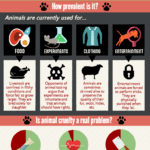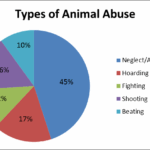Animal cruelty is often perceived as an isolated issue, a social blight with its roots in a spectrum of psychological dysfunction. However, the ramifications of such cruelty extend far beyond the immediate suffering of the animals involved. Researchers and law enforcement officials are increasingly recognizing the crucial link between animal cruelty and violent human behavior. By studying patterns of animal abuse, experts in behavioral analysis, such as those at the FBI, can uncover insights that may help in solving violent crimes. This relationship is not just an academic exercise; it offers a profound promise for a shift in perspective that may ultimately aid in mitigating violence in society.
Historically, there has been an established connection between individuals who commit violent acts against animals and those who perpetrate violence against humans. Early research indicates that approximately 70% of individuals who were arrested for violent offenses had also engaged in acts of animal cruelty at some point in their lives. This alarming statistic prompts a deeper investigation into the mindset of perpetrators. By understanding their motivations and psychological profiles, it becomes possible to anticipate and perhaps even prevent further violent actions.
The FBI’s Behavioral Analysis Unit (BAU) employs a plethora of psychological frameworks to dissect behavioral patterns that are often indicative of deeper sociopathic tendencies. They examine not only the circumstances surrounding acts of animal cruelty but also the behavior of the individual before, during, and after the act. Such a nuanced analysis can reveal underlying pathological traits, impulsive aggression, or the need for control. By investigating these factors, law enforcement can establish a broader profile of potential offenders, which may prove invaluable in apprehending individuals involved in violent crimes against humans.
One significant angle of this investigation is the psychological phenomenon known as “zoosadism.” This term refers to individuals who derive pleasure from inflicting pain on animals. Some of these offenders exhibit a remarkable degree of callousness, which is often accompanied by a history of other antisocial behaviors. Recognizing zoosadism as a potential precursor to future violence can help law enforcement identify high-risk individuals before they escalate their behaviors to include violence against humans. In this regard, studying animal cruelty provides a lens through which a broader understanding of violent crime can be achieved.
The link between animal cruelty and domestic violence is particularly noteworthy. Numerous studies have shown that animal abuse is frequently present in households where domestic violence occurs. Perpetrators often harm pets as a means of control or manipulation, using the threat of violence against animals to intimidate their victims. By focusing on animal cruelty in these contexts, investigators can uncover patterns that point to larger issues of domestic abuse. Inclusion of animal welfare considerations in domestic violence cases could facilitate interventions that not only safeguard human victims but also protect innocent animals caught in the crossfire.
Moreover, incorporating animal cruelty into routine investigations could change the way society perceives and addresses violent crime. The field of criminology continues to evolve, often disregarding the troubling connection between animal cruelty and human violence. By elevating the discourse around animal rights and welfare, society can challenge the misconceptions that have historically downplayed the significance of these acts. As awareness grows, so does the imperative for law enforcement agencies to adopt comprehensive policies that include animal abuse as a critical indicator of potential future violence.
In practical terms, building training programs that sensitize law enforcement officials to the connections between animal cruelty and violent crime can have far-reaching implications. Collaborations with animal welfare organizations can also enhance investigative efforts. These partnerships can provide valuable support, further enabling law enforcement to develop effective strategies for addressing the intertwining issues of animal cruelty and human violence.
Awareness campaigns and educational initiatives aimed at the public can serve as powerful tools in this regard. Demonstrating that animal cruelty can be a red flag for more serious violent tendencies informs not only potential victims but also encourages responsible pet ownership and proactive intervention. Societal transformation begins with education, and fostering compassion towards animals leads to healthier attitudes towards all forms of life.
It is essential to review the legal framework surrounding animal cruelty. Some jurisdictions still treat animal abuse as a minor offense, leading to insufficient penalties that fail to deter potential offenders. Strengthening legislation and improving enforcement can send a powerful message that animal cruelty will not be tolerated, thereby promoting a culture of respect for all living beings. Furthermore, collaboration among lawmakers, forensic psychologists, and criminal profilers can lead to more effective policies aimed at addressing this issue holistically.
The pursuit of knowledge regarding animal cruelty is not solely an academic endeavor; it is a crucial aspect of social reform. As research delves deeper into this interrelation, the potential to break the cycle of violence becomes ever more tangible. The comprehensive study and understanding of animal abuse cannot only enhance criminal investigations but serve as a catalyst for broader societal change.
In conclusion, the impact of studying animal cruelty extends far beyond the confines of individual cases. It offers profound insights into understanding violent crime and its origins. By forging a stronger connection between animal welfare and public safety, society stands a better chance of addressing the roots of violence itself. The time has come for both individuals and institutions to reevaluate their perspectives on animal cruelty, recognizing its implications not just for animals, but for the entire fabric of our communities.







